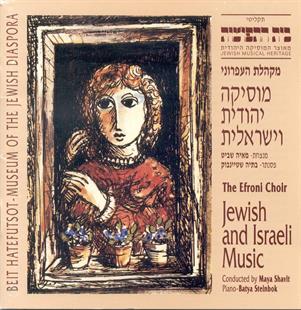
Minhag Chadash from The Golden Peacock for girls' choir and piano (1984)
Minhag Chadash Ba LaMedina ("A Brand-New Fashion" - in Hebrew)
Original recording from The Efroni Choir: Jewish and Israeli Music. Produced by Beit Hatfutsot in 1991.
This love song by Haim Nachman Bialik as composed by Yehezkel Braun as the fourth movement in his piece "The Golden Peacock".
Yehezkel Braun
(Personality)Yehezkel Braun (1922-2014), composer, born in Breslau, Germany (now Wroclaw, Poland). He came to Eretz Israel at the age of two and was brought up in close contact with Jewish and East Mediterranean traditional music. Braun graduated the Israel Academy of Music, Tel Aviv, where he studied with Alexander U. Boskovich, among others, and holds a master’s degree in Classical Studies from Tel Aviv University. In 1975 he studied Gregorian chant with Dom Jean Claire at the Benedictine monastery of Solesmes, France. Braun taught at the Rubin Academy of Music, Tel Aviv, and was its director between 1979-1981. His main academic interests are traditional Jewish melodies and Gregorian chant and he lectured on these and other subjects at universities and congresses in Israel and abroad.
Braun’s works clearly reflect the influence of his personal background. He composed choral music with instruments (FESTIVE HORNS, 1977, SONGS AND BALLADS BY H.N.BIALIK, 1984, KING DAVID’S LYRE, 1990) and a cappella (SHARKIYA, 1967, CANTICI CANTICORUM III, 1973, HE WILL PROCLAIM FREEDOM, 1978, EARLY MORNING MISTS, 1989), songs (THE LOVE OF THERESE DU MEUN, 1962), orchestral works (PSALM, 1959, CONCERTO for clarinet and chamber orchestra, 1987, CONCERTO for harp and orchestra, 1991), and chamber music (SONATA for piano, 1957, PIANO TRIO, 1988). Among Braun’s writings are Studies in the Jerusalem Sephardic Melos (1984), Le chant du Pentateuque dans la synagogue et la modalite archaique gregorienne (1985) and Aspects of Melody (1992).
Haim Nachman Bialik
(Personality)Haim Nachman Bialik (1873 -1934), poet, essayist, writer, translator and editor, born in Radi (aka Hrada) near Zhitomir, Ukraine (then part of the Russian Empire), to a poor family. He was sent in 1880, after his father’s death, to his paternal grandfather with whom he lived for ten years. He was first instructed in a heder, later pursued his studies alone and furthered them from 1890 at a yeshivah in Volozhin, Lithuania. During his studies there Bialik started to withdraw from religion and read Russian poetry and world literature. He was also introduced to Haskalah literature and considered Ahad Ha-Am his greatest mentor. In 1891 he stayed for six months in Odessa and made the acquaintance of leading figures in literature with whom he later developed lasting relationships, among them Yehoshua Rawnitzki.
In 1893 Bialik married Manya Averbuch. In 1897, after failing in business, he became a teacher in Sosnowiec near the Prussian border. His despair with contemporary Jewish life was relieved with the First Zionist Congress and he welcomed the flourishing national enthusiasm. In 1900 he managed to get a teaching position in Odessa where he lived until 1921. There he joined the literary and Zionist circles. The Kishinev pogroms in 1903 deeply shocked him. In 1904 he was appointed editor of Ha-Shilaoh and moved to Warsaw. He held the position until 1909 and later served as editor of Keneset (1917) and Reshumot (1918-1921).
In 1921 Bialik went to Berlin where he lived until 1924 when he settled in Eretz Israel. In Palestine he founded the literary magazine Moznayim.
Bialik’s first poem, El ha-Zippor (To the Bird) was written in Volozhin. Upon his return to Zhitomir from his first stay in Odessa he wrote Bi-Teshuvati (On my Return, 1892) and El ha-Aryeh ha-Met (To the Dead Lion, 1893). Soon after his marriage he wrote the poems Al Saf Beit ha-Midrash (On the Threshold of the House of Study, 1894) and Ha-Matmid (The Talmud Student, 1894-95). During his time in Sosnowiec Bialik wrote some stories (among them, Aryeh Ba’al Guf) and the poem Akhen Hazir ha-Am (Surely the People is Grass, 1897). In Odessa he wrote the poems Zohar (Radiance, 1901); Metei Midbar (The Dead of the Desert, 1902), Al ha-Shehitah (On the Slaughter, 1903), Be-Ir ha-Haregah (In the City of Slaughter, 1904), Ha-Berekha (The Pool, 1905), Megillat ha-Esh (The Scroll of Fire, 1905) and Safi’ah (Aftergrowth, 1908), the story Me-Ahorei ha-Gader (Behind the Fence, 1909) and Zanah lo Zalzal (A Twig Fell, 1911). Together with Rawnitzki, Bialik compiled a selection of rabbinic lore, Sefer ha-Agadah (1908-1911). In Palestine he wrote the poem cycle Yatmut (Orphanhood, 1933).
He died in Vienna, Austria, where he had gone for medical treatment and was buried in Israel.